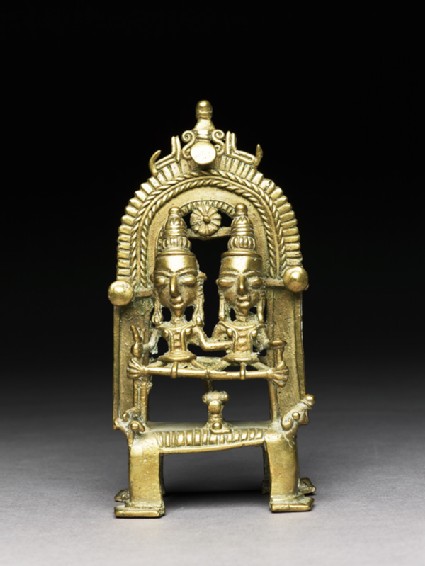Room 32 | India 600-1900 gallery
Explore Hindu, Buddhist and Jain art from India, the Himalayas and Southeast Asia.

Galleries : 299 objects
Figure of Shiva and Parvati
-
Details
- Associated place
-
Asia › India › central India › Madhya Pradesh (place of creation)
- Date
- 18th - 19th century (1701 - 1900)
- Material and technique
- brass
- Dimensions
- 14.8 x 7.5 x 5.4 cm max. (height x width x depth)
- Material index
-
processed material › metal › alloy › copper alloy › brass
- Technique index
- Object type index
- No. of items
- 1
- Credit line
- Presented by Mrs C. E. Luard, 1936.
- Accession no.
- EAX.283
-
Further reading
Harle, J. C., and Andrew Topsfield, Indian Art in the Ashmolean Museum (Oxford: Ashmolean Museum, 1987), no. 71b on pp. 61-64, pp. xii & 63, illus. p. 62
Location
Objects are sometimes moved to a different location. Our object location data is usually updated on a monthly basis. Contact the Jameel Study Centre if you are planning to visit the museum to see a particular object on display, or would like to arrange an appointment to see an object in our reserve collections.
Publications online
-

Indian Art in the Ashmolean Museum
These seven objects belonged to a large collection of brass images, ritual objects, implements, ornaments and toys which was formed by Major (later colonel) C. Eckford Luard in the former Central Indian Agency between 1900 and 1903. Luard served in this area for a number of years as Superintendent of Gazetteer and of Census Operations. He compiled the several volumes of Central Indian State Gazetteers (1907-12), as well as writing other works, including guide-books to Dhar and Mandu and the Dilwara temples at Mount Abu. In later life he lived at Boar’s Hill, Oxford, and part of his collection was presented to the Indian Institute’s museum by his widow in 1936 [see EAOS.108]. Luard’s earlier article describing the collection in the Journal of Indian Art and Industry is still useful in the identification of regional types of such late brass objects, which are otherwise scantily documented.
Images of gods, as might be expected, formed the larger part of Luard’s collection. Some, like the figure of the Durgā killing the buffalo-demon [EAX.280], adhere loosely to classical canons of iconography [see EAOS.64], while others are in a more janglī (rustic) idiom, such as a seated group of Śiva and Pārvatī with a stylized Nandī at their feet [EAX.283].
Galleries
Notice
Objects may have since been removed or replaced from a gallery. Click into an individual object record to confirm whether or not an object is currently on display. Our object location data is usually updated on a monthly basis, so contact the Jameel Study Centre if you are planning to visit the museum to see a particular Eastern Art object.
© 2013 University of Oxford - Ashmolean Museum






